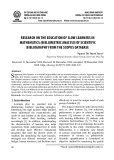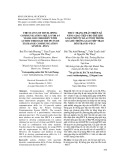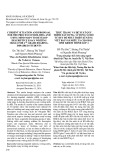
302
HNUE JOURNAL OF SCIENCE
Educational Sciences 2024, Volume 69, Issue 5A, pp. 302-308
This paper is available online at https://hnuejs.edu.vn/es
DOI: 10.18173/2354-1075.2024-0105
COMPREHENSIVE EARLY FAMILY INTERVENTION FOR CAREGIVERS OF
CHILDREN WITH DEVELOPMENTAL PARENT TRAINING PROGRAM FOR
ELEMENTARY SCHOOL STUDENTS WITH AUTISM SPECTRUM DISORDERS
Taishi Takezawa*1, Ritsuko Horikawa2 and Yoshiko Kuriyama2
1Wakayama University, Wakayama city, Japan
2Aitoku Medical and Social Welfare Center, Wakayama city, Japan
*Corresponding author: Taishi Takezawa, email: takezawa@wakayama-u.ac.jp
Received November 22, 2024. Revised December 2, 2024. Accepted December 13, 2024.
Abstract. The purpose of this study was to implement a psychological program based on
parent training for caregivers of elementary school students with Autism spectrum disorders
(ASD) and to examine the effectiveness of the program. The gender of the 22 parents was all
female, with a mean age of 40.95 years (SD 5.08). The content of the program included
learning how to objectively view their children's behavior in a systematic way and providing
positive feedback on their children's positive behavior. Each session of the program lasted
approximately two hours and was conducted a total of nine times over a period of
approximately eight months. At the beginning and end of the program, parents and children
were measured using three psychological scales. After the program, the parents' negative
attitudes toward child-rearing tended to improve. In addition, there was a tendency for the
children's communication and daily living skills to develop. Finally, with regard to the
parents' mental health, there was a trend toward a reduction in depression. Finally, the
participants discussed issues related to the effectiveness and evaluation of the program, as
well as ways to improve the content of the program.
Keywords: psychological program, Autism Spectrum Disorders (ASD), elementary
school students, behavior, parent training program, caregivers.
1. Introduction
Psychological support for families of children with developmental disabilities, especially
for caregivers, has played an important role in supporting families of children with disabilities.
Many practical studies have been conducted, and a number of research findings on parent
training have been reported. Among the studies on the effectiveness of parent training, practical
studies focusing on the relationship between the nurturing attitudes of caregivers of elementary
school children and their children's adaptive behavior are of great value.
Nakajima, et al. (2012) reported that parents of children with developmental disabilities are
less positively involved and more negatively involved than other parents of typically developing
children [1][2]. It has also been reported that children with ASD show difficulties during
childhood in terms of adaptation to their environment and social development compared to their
peers (McStay, et al. 2014) [3]. Although parent training offers an effective solution to these
issues, there are reports that parental depression affects the effectiveness of parent training
(Menta, 2011) [4]. As described above, few studies have examined in detail how the knowledge
and skills gained through parent training affect the adaptive behavior of elementary school

Comprehensive early family intervention for caregivers of children with developmental…
303
students through their parents' nurturing behavior. This study aims to examine the effects of a
parent training-based program for caregivers of elementary school children through the analysis
of changes in caregivers' nurturing attitudes, children's adaptive behavior, and caregivers' mental
health [5], [6].
2. Content
2.1. Research period
The study was conducted from April 2020 to March 2023.
2.2. Participants
A total of 22 caregivers of children with ASD participated in the program from FY2020 to
FY2023. All participant children were diagnosed at a medical facility and then referred to the
program. All caregivers signed a consent form to participate in the study after the program was
explained to them. All participants were female. Table 1 shows the age of the participants and the
age of their children in months. The age of the participants was 40.95 years with 5.08 of standard
deviation. The age of their children was 85.59 months with 15.04 of standard deviation.
Table 1. Age of the participants/the children
Average
SD
Age of the Participants
40,95
5,08
Age in Month in the Children
89,59
15,04
Figure 1 shows the gender of the children. 86.36% were male and 13.64% were female.
Figure 1. Gender of children
Figure 2. Birth order of children
Figure 2 shows the birth order of the children. Among the children the first child was 48.50%,
the second child was 12.10%, and the third child was 6.10%. Figure 2. Birth order of children

Taishi T*, Ritsuko H & Yoshiko K
304
2.3. Measurements
2.3.1. Positive and Negative Nurturing Behavior Scale
The Positive and Negative Parenting Behavior Scale (PNPS) is a questionnaire that
comprehensively assesses parenting behavior, both positive and negative aspects of parenting
(hereafter referred to as PNPS). Participants were asked to complete the PNPS at the beginning
and end of the program.
2.3.2. Vineland Adaptive Behavior Scale
The Vineland Adaptive Behavior Scale assesses the ability to perform daily activities
necessary for personal and social fulfillment (hereafter referred to as Vineland-II). The Vineland-
II was administered to participants at the beginning and end of the program through interviews.
2.3.3. General Health Questionnaire
The General Health Questionnaire is a screening test for psychological assessment and
detection of persons with neurological disorders (hereafter referred to as GHQ). Participants were
asked to complete the GHQ at the beginning and end of the program.
2.3.4. Programs
A total of 9 sessions were implemented by two specialists for approximately 8 months. Each
session of the program lasted approximately two hours with four to six participants. The themes
of each session included understanding the characteristics of children, basic responses to children,
and specific behavioral analysis. The participants had opportunities to learn how to objectively
view child’s behavior in a systematic way, as well as providing positive feedback on a child's
positive behavior. Table 1 shows the themes of each session.
Table 2. Thems of each session
1
Learning about the characteristics of children
2
How to effectively communicate with your Child
3
Creating a support book
4
How to praise your child effectively
5
How to give your child effective instruction
6
How to recognize a child’s challenging behavior
7
How to respond to a child’s challenging behavior
8
Roundtable discussion and information exchange
9
Special lectures by parent mentors
2.4. Results
**p<0.1, *p<0.05
Figure 3. Subscale scores of the PNPS

Comprehensive early family intervention for caregivers of children with developmental…
305
The PNPS scores
Figure 3 shows the PNPS scores of the participants at the beginning and end of the program.
Comparing the scores before and after the program, the scores at the end of the program decreased
in “severe reprimand and corporal punishment,” which were statistically significant (t = 2.22, p <
0.05).The Vineland-II scores
Figure 4 shows the participants' Vineland-II total scores and scores on the three subscales at
the beginning and end of the program. Comparing the scores before and after program
implementation, the scores at the end of the program were significantly higher for
“communication” and “daily living skills” (t = 3,16, p < 0.05; t = 3,20, p < 0.05, respectively).
**p<0.1, *p<0.05
Figure 4. Total and Subscale scores of Vinland-Ⅱ
**p<0.1, *p<0.05
Figure 5. Scores of sub-domains in Vinland-Ⅱ
Figure 5 shows the participants' scores in the nine Vineland-II subdomains at the beginning
and end of the program. Scores at the end of the program were significantly higher in the receptive
language, expressive language, and personal independence domains (t = 2.66, p < 0.05; t = 4.15,
p < 0.05; t = 4.34, p < 0.05, respectively).
Figure 6 shows the participants' Vineland-II maladaptive behavior scores at the beginning
and the end of the program. In the “Maladaptive Behaviors” domain, scores increased at the end
of program, which was significantly significant (t = 3.09, p < 0.05).

Taishi T*, Ritsuko H & Yoshiko K
306
**p<0.1, *p<0.05
Figure 6. Scores of maladaptive behaviors in Vineland-II
The GHQ scores
Figure 7 shows the participants' overall GHQ scores and scores on the four subscales at the
beginning and end of the program. Comparing the scores before and after the program
implementation, the scores at the end of the program were significantly decreased in “depression.”
(t = 2.94, p < 0.05).
**p < 0.1, *p < 0.05
Figure 7. GHQ scores
2.5. Discussion
In this study, a family support program based on parent training ideas was implemented and
its effectiveness was examined. At the end of the program, among the negative nurturing attitudes
toward children among caregivers, “reprimand and corporal punishment” in particular showed a
tendency to improve. On the other hand, no significant changes were observed in other negative
and positive child-rearing attitudes. It was expected that the negative nurturing attitudes of the
caregivers would improve and positive nurturing attitudes would increase through participation
in the program, but such results were not obtained. It is suggested that the content of the parent
training-based program may not have contributed to improving caregivers' negative nurturing





















![Định hướng giáo dục STEM trong trường trung học: Tài liệu [chuẩn/mới nhất]](https://cdn.tailieu.vn/images/document/thumbnail/2025/20251124/dbui65015@gmail.com/135x160/25561764038505.jpg)




